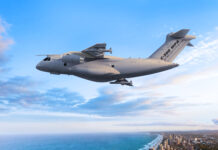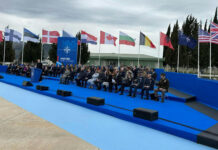Embraer has launched a NATO-configured version of its A-29 Super Tucano turboprop light attack aircraft/trainer, the company announced at the LAAD 2023 defence exhibition in Rio de Janeiro on 12 April 2023.
Known as the A-29N, the new variant is initially focused on meeting the needs of European air forces and includes new equipment and features to fulfil NATO operational requirements, such as a new datalink and single-pilot operation.
These features will expand the aircraft’s potential mission set, for example by allowing it to be used for Joint Terminal Attack Controller (JTAC) training. The A-29’s training devices will also be upgraded to accommodate virtual, augmented, and mixed-reality training scenarios.
“This is a new stage in the operational life of the A-29 Super Tucano,” Bosco da Costa Junior, President and CEO of Embraer Defense and Security, was quoted as saying in a company press release. “We see many application possibilities for the A-29N at the moment. Several European countries have shown interest in specific aircraft capabilities that we have now introduced with this version.”
With more than 260 units delivered worldwide, the A-29 is in service with several air forces. Brazil is unsurprisingly the largest user, with around 80 A-29A/Bs in service of 99 originally ordered. As well as also being in service with the air forces of Chile, Colombia, the Dominican Republic, Ecuador, Honduras, Indonesia, Lebanon, Mauritania, Nigeria and the Philippines, the A-29 was evaluated by the US Air Force under its eventually cancelled Light Air Support (LAS) programme. The US government had also delivered around 19 A-29s to the Afghan Air Force by the time of the Taliban takeover of Afghanistan in August 2021. A number of these aircraft were evacuated to Uzbekistan and Tajikistan, with no A-29s known to be in service with the Taliban’s Islamic Emirate Air Force.
Developed to be versatile, the Super Tucano can perform a broad range of missions, including light attack, armed surveillance, air interception/policing, counter-insurgency missions, and advanced turboprop training. It can operate from remote and unpaved runways on forward-deployed operational bases with little support, with Embraer also touting its low operating costs and high availability rates (above 90%).
The A-29’s effectiveness as a trainer is also enhanced by its ability to simulate combat missions and upload and download flight data.
Given the A-29’s versatility, Embraer appears to be banking on a NATO-compliant Super Tucano finding favour with some of the more recent alliance member nations who might be looking to build a flexible and affordable air component with a fleet that can offer training, light attack and other capabilities in the same platform.
Peter Felstead












